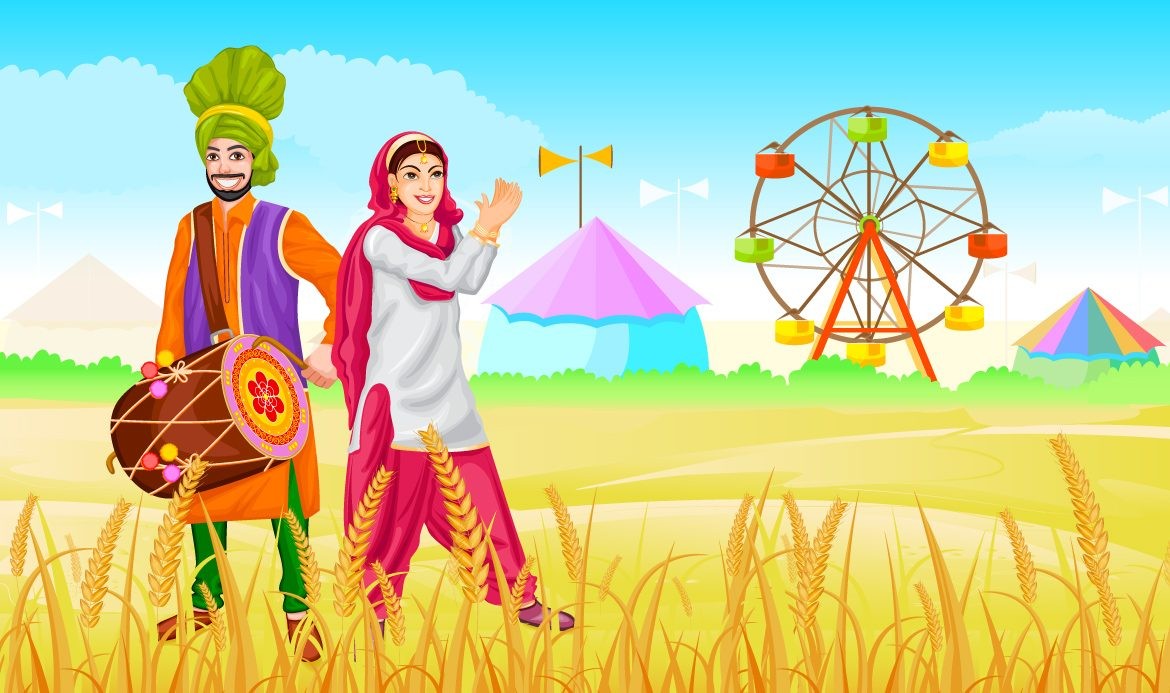Baisakhi Festival falls on April 14th and marks the beginning of the solar year. People of North India, particularly in Punjab celebrate the festival as a of thanking the God for good harvest. They visit to Gurudwaras, Vaisakhi processions and traditional performances are the highlights of the day. Baisakhi has special significance for Sikhs as on this day in 1699, their tenth Guru Gobind Singh Ji organized the order of the Khalsa.
Joyful festival of Baisakhi is celebrated with lot of charm and gusto in the vibrant state of Punjab. People perform set Baisakhi customs and traditions for the day with sincerity and devotion. Since Baisakhi is celebrated as the birth of Guru Gobind Singh – the Tenth Sikh Guru and the foundation day of Khalsa Panth, major activities for the festival are centred on gurdwaras – the Sikh place of worship. As a harvest festival Baisakhi is celebrated in open fields with energetic bhangra and gidda dance by gaily dressed men and women of Punjab.
People following Sikh faith wake up early in the morning on a Baisakhi day and pay visit to gurdwaras to attend special prayer meetings. While most Sikhs strive to visit the revered Golden Temple or Anandpur Sahib, where the Khalsa was pronounced, those who are unable to do so visit their neighbourhood gurdwara.
At a gurdwara, the Guru Granth Sahib, the holy book of Sikhs is ceremonially taken out and is given a symbolical bath with milk and water. After these simple rituals, Guru Granth Sahib is placed on its throne with care. The book is then read out to the followers gathered in the gurdwara.

History of Baisakhi
Baisakhi or Vaisakhi Festival is celebrated as the Sikh New Year and the founding of the Khalsa Panth. History of Baisakhi traces its origin from the Baisakhi Day celebrations of 1699 organized by the Tenth Sikh Guru, Guru Gobind Singh to form Khalsa – Brotherhood of Saint Soldiers to fight against tyranny and oppression.
Story of Baisakhi
The story of Baisakhi Festival began with the martyrdom of Guru Teg Bahadur, the ninth Sikh Guru who was publicly beheaded by the Aurungzeb, the Mughal ruler. Aurungzeb wanted to spread Islam in India and Guru Tegh Bahadur stood up for the rights of Hindus and Sikhs and the Mughals therefore saw him as a threat.
After the death of Guru Teg Bahadur, his son, Guru Gobind Singh became the next Guru of the Sikhs. Guru Gobind Singh wished to instill courage and strength to sacrifice among his fellow men. To fulfil his dream, Guru Gobind Singh called on the historic Baisakhi Day congregation of Sikhs at Keshgarh Sahib near Anandpur on March 30, 1699.
When thousands of people assembled for Guru’s blessing, Guru Gobind Singh came out of the tent carrying an unsheathed sword. He gave a powerful speech to infuse courage amongst fellowmen. At the end of the speech he said that every great deed was preceded by equally great sacrifice and demanded that anyone prepared to give his life come forward. On the Guru’s third call, a young man offered himself. The Guru took the man inside a tent and reappeared alone with a bloodied sword. Guru Gobind Singh asked for another volunteer. This was repeated another four times until a total of five Sikhs had gone into the tent with the Guru. Everyone present was worried and though that Guru Gobind Singh has killed five Sikhs. At this point Guru presented all the five men before the people. Every one present was surprised to see all five men alive and wearing turbans and saffron-coloured garments.

These five men were called Panj Piara or ‘Beloved Five’ by the Guru. The Guru blessed them with a Pahul ceremony. In an iron vessel, the Guru stirred with a sword called Khanda Sahib, the batasha that his wife, Mata Sundari Ji had put into water. The congregation recited verses from scriptures as the Guru performed the sacred ceremony. The water was now considered the sacred nectar of immortality called amrit. It was first given to the five volunteers, then drunk by the guru and later distributed amongst the crowd. With this ceremony, all those present, irrespective of caste or creed, became members of the Khalsa Pantha (the Order of the Pure Ones).
The Guru regarded the Panch Piaras as the first members of the Khalsa and the embodiment of the Guru himself. With the constitution of the Panj Pyare the high and low castes were amalgamated into one as among the original Panj Pyare, there was one Khatri, shopkeeper; one Jat, farmer; one Chhimba, calico printer; one Ghumar, water-carrier; and one Nai, a barber. The Guru gave the surname of Singh (Lion) to every Sikh and also took the name for himself. From Guru Gobind Rai he became Guru Gobind Singh. This was seen as a great step in national integration because society at that time was divided on the basis of religion, caste and social status.
Guru Gobind Singh also bestowed on Khalsa, the unique Sikh identity. He directed Sikhs to wear five K’s: Kesh or long hair,
Kangha or comb,
Kripan or dagger,
Kachha or shorts and a
Kara or bracelet.
Guru Gobind Singh also discontinued the tradition of Gurus and asked all Sikhs to accept the Grantha Sahib as their eternal guide. He urged them to come to him with their hair and beard unshorn to get baptized by the sword.

Birth of Khalsa
The day of Baisakhi marks the birth of Khalsa Panth and therefore holds tremendous significance for the Sikhs. It was on the Baisakhi Day meeting organized at Anandpur Sahib, in 1699, that the tenth Guru of Sikhs, Guru Gobind Sigh laid the foundation of Khalsa Panth and called on the Sikhs to sacrifice themselves for their community.
Besides, it was on the Baisakhi Day that Guru Gobind Singh administered amrit (nectar) to his first batch of five disciples, the Panj Piaras making them Singhs, a martial community. After the Baisakhi Day in 1699 the tradition of gurus was discontinued, and the Granth Sahib – the Holy book of the Sikhs was declared the eternal guide of the Sikhs.
Legends of BaisakhiAccording to a popular legend in Sikhism, it was on the day of Baisakhi in 1567 that Guru Amar Das had first institutionalized Baisakhi as one of the special days when all Sikhs would gather to receive the guru’s blessings at Goindwal.
Legends
There are various legends associated with the colourful and vibrant festival of Baisakhi. A study of these interesting legends of Baisakhi reveal that the day of Baisakhi is significant not just for Sikhs but also for Hindus and Buddhists alike. Besides, it is joyous to note that as a harvest festival, people of all communities in Punjab celebrate Baisakhi in a harmonious manner.

Baisakhi as Harvest Festival
Baisakhi Festival marks the time for the harvest of Rabi crops and is therefore celebrated with utmost joy and enthusiasm in the state of Punjab where agriculture is the predominant occupation of the people. To celebrate the occasion, people dress themselves gaily and perform the joyful bhangra and giddha dance on the tune of the dhol. Farmers in Punjab celebrate Baisakhi Festival to hilt by feasting and merrymaking before they hit on tiring but joyful task of harvesting from the next day.
As a harvest festival, Baisakhi is also celebrated by different names and with different rituals in several regions of India. Regional celebrations of Baisakhi are marked as Rongali Bihu in Assam, Naba Barsha in Bengal, Puthandu in Tamil Nadu, Vishu in Kerala and Vaishakha in Bihar.
Social Significance of Baisakhi Day
Apart from fighting the political tyranny, Guru Gobind also sought to eliminate social discriminations in the name of caste with the establishment of Khalsa Panth. The Panj Piyaras set by the Guru amalgamated people of low and high caste into one as it consisted of people of different strata of the society.
To further do away with the system of caste discrimination and to give to all Sikhs an opportunity to live lives of courage, sacrifice, and equality, the Guru gave the surname of Singh (Lion) to every Sikh and also took the name for himself. From Guru Gobind Rai, he became Guru Gobind Singh. He also pronounced that all Sikh women embody royalty, and gave them the surname Kaur (Princess).

Baisakhi Processions
Baisakhi Customs and TraditionsLater, during the Baisakhi day, sacred Guru Granth Sahib is taken out in a procession. At the head of the procession are the Panj Piaras, symbolizing the journey made by the five fearless devotees from their homes to Anandpur, to be baptised by Guru Gobind Singh. Baisakhi processions are attended by men, women and children alike with faith and enthusiasm. The procession moves through major localities of the city and is welcomed by citizens and members of social and cultural societies. Colourful bhangra and gidda dance apart from mock duels are performed during Baisakhi processions. Another fascinating part of Baisakhi celebrations is the accompaniment of drummers, bands playing religious times, devotees singing religious songs and men swinging swords.
Loud Sikh chants of ‘Bole so nihal’, ‘Deg teg fateh’ and rhythmic chants of ‘Sat nam’ and ‘Wahe guru’ ring out from the middle of the singing and drumming. Some men may wear the headgear (bana) of Guru Nanak, others that of Guru Gobind Singh. In their discourse at the end of the ceremony, Sikh religious leaders strive to promote the feeling of charity amongst people, especially children in honor of Guru Gobind Singh.
Thanksgiving Day
Festival of Baisakhi is celebrated as a Thanksgiving Day by the farmers. People wake up early on the day and take bath in rivers or pond water and pay a visit to the temple or gurdwara (Sikh worship place). Farmers thank god for the bountiful harvest and pray for prosperity in future also. Many people also perform charity on the day as a custom.
Must read Tamil New Year : Puthandu – Traditions and Rituals
Must read The Hindu New Year – Different regions and different flavours of Celebration








